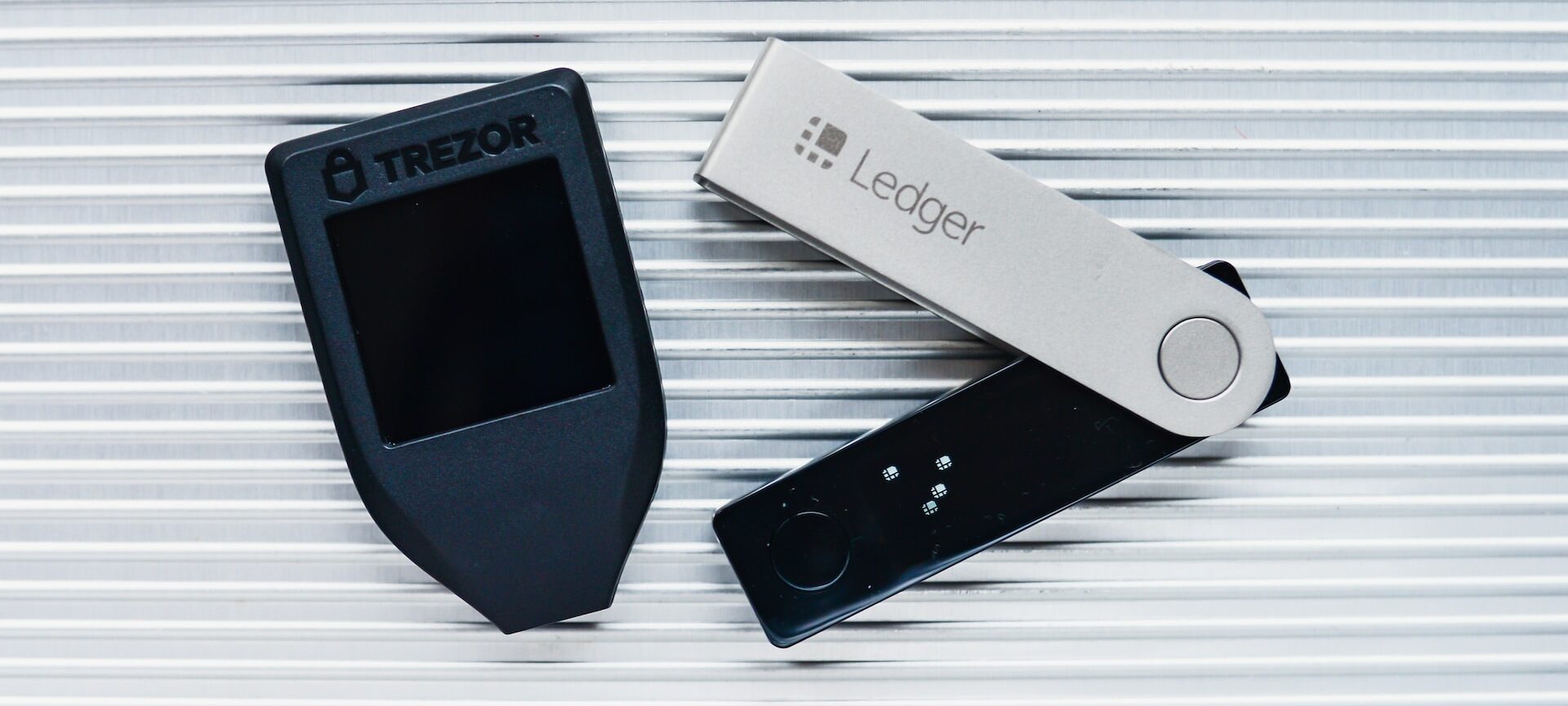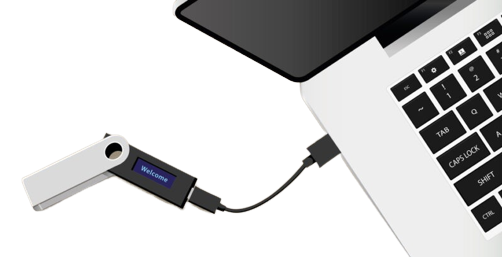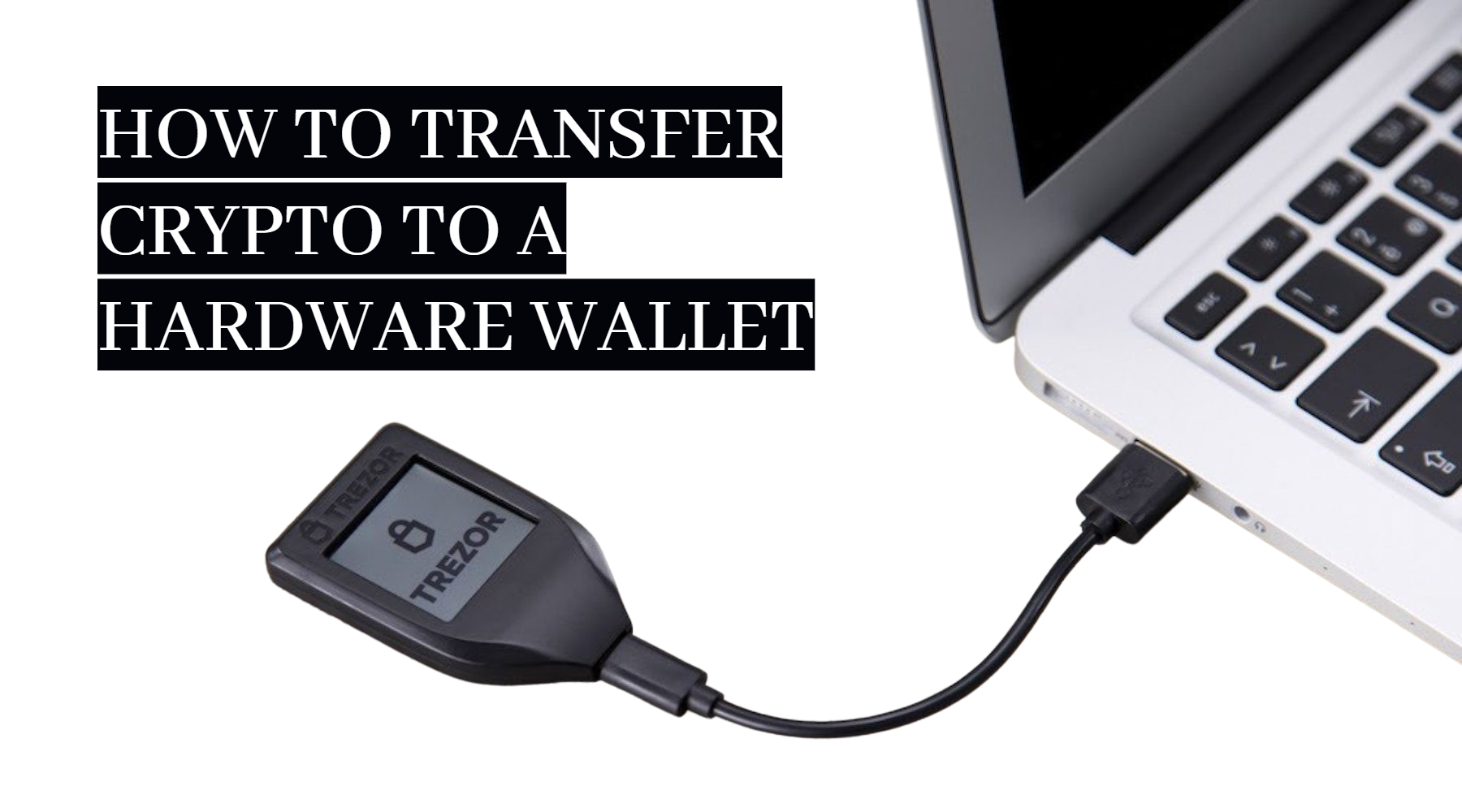
Table of Contents
- What is a hardware wallet?
- How does a hardware wallet work?
- How to set up a crypto hardware wallet
- How to transfer crypto to a hardware wallet
- How secure is a hardware wallet?
- Pros and cons of hardware wallets
- What should you look out for when buying a hardware wallet?
- FAQs
Hardware wallets or cold wallets are the safest solution for long-term crypto investments! If you want to HODL your coins and tokens over a longer period of time, their safe custody plays a significant role.
But what are hardware wallets and how do they work? Find out why they are indispensable and how you can use them to protect your Bitcoins & Co. easier and better than just the right crypto wallet.
What is a hardware wallet?
A hardware wallet is a type of physical wallet for cryptocurrencies. In such a wallet you can keep your cryptocurrencies safe from access by other users.
The aspect of security is also crucial here because investors who have larger assets in Bitcoin, Ethereum, or other cryptocurrencies should definitely deal with the safekeeping of these assets.
A hardware wallet appears inconspicuous, as it’s an external device that needs to be connected to another device, such as a laptop or smartphone.

The actual transaction is then initiated on the connected end device and carried out securely on the wallet. The actual transactions take place on the external wallet.
This makes it even more difficult for attackers to manipulate transactions or hack wallets. This is also the reason why hardware wallets are probably the safest storage option for cryptocurrencies.
Why security matters in cryptocurrency
Cryptocurrencies have revolutionized financial transactions, but the digital nature of these assets also poses inherent risks. Cyberattacks, hacking attempts, and scams target individuals and exchanges.
Security breaches can result in catastrophic loss of funds. Thus, the urgency to safeguard digital wealth has never been greater.
Hardware wallets address these concerns by creating a barrier between your assets and online vulnerabilities.
How does a hardware wallet work?
Anyone who hears about a hardware wallet for the first time and has only kept their cryptocurrencies on a crypto exchange such as Coinbase or Binance will certainly ask themselves how such a crypto wallet actually works.
Inside the crypto hardware wallet, there’s a special place where your private keys are stored. Private keys are like secret codes that only you should know. They’re what you need to access and control your cryptocurrencies. Since these keys are super important, the hardware wallet keeps them locked away inside, safe from any potential online hackers.
When you want to make a transaction, like sending or receiving cryptocurrency, you plug your hardware wallet into your computer or smartphone. It then creates a secure connection and helps you sign the transaction using your private keys. The cool part is that even though you’re connected to the internet, your private keys never leave the hardware wallet. This means that hackers can’t get to them, even if they try.
How to set up your hardware crypto wallet
Basically, the available hardware wallets are very similar, so the setup process are usually the same.
Of course, there are differences between the individual manufacturers, but these are marginal and are not considered in this quick start guide.
You can find more detailed instructions for setting up the individual hardware wallets in the respective reviews.
- Compare product: In our crypto hardware wallet comparison, we compared the most well-known cold storage wallets for you.
- Order wallet from the manufacturer: It is important that you always order your wallet from the manufacturer. Intermediaries could manipulate your wallet and get your cryptocurrencies.
- Check the packaging: The first thing to check upon receipt is the packaging. Is the manufacturer’s seal or vacuum packaging still intact? Some devices, such as the Ledger Nano S Plus, detect whether the built-in hardware has been tampered with when plugged in.
- Setup: Use the included instructions or follow the setup steps as per the instructions on the manufacturer’s website. In just a few steps you have set up your wallet and connected it to your device.
- Create a backup: This step is essential! Be sure to back up your device. This way you can restore it if it gets lost or broken.
Watch the video below and learn how to set up your hardware wallet in a few easy steps.
How to transfer crypto to a hardware wallet

Transferring cryptocurrency to a hardware wallet is like moving your digital money to a super secure vault. Here’s how you do it:
- Get Your Hardware Wallet Ready: First, make sure your crypto hardware wallet is set up and ready to go. Follow the instructions that came with it to get it all prepared.
- Open Your Software Wallet: If you’ve been keeping your cryptocurrency on a software wallet or an exchange, open it up.
- Locate the “Send” Option: Look for the option that says “Send” or “Withdraw” in your software wallet. This is like telling your wallet that you want to move your crypto.
- Enter the Address: In your hardware wallet, find your public address. It’s a long string of letters and numbers, kind of like an account number. Copy this address.
- Paste the Address: Go back to your software wallet and paste the hardware wallet’s address into the “Recipient Address” field. Make sure you’ve got it right – one small mistake here could send your crypto to the wrong place!
- Enter the Amount: Tell your software wallet how much cryptocurrency you want to send to your hardware wallet. Make sure you’re sending the right amount!
- Confirm the Transaction: Review everything carefully. Once you’re sure, hit the “Confirm” or “Send” button. Your software wallet will start the process of moving your crypto.
- Wait for Confirmation: This part might take a little while. The blockchain needs to verify the transfer, so be patient.
- Check Your Hardware Wallet: After a bit, check your hardware wallet. You’ll see your cryptocurrency safely stored there!
Remember, the whole point of using a hardware wallet is to keep your cryptocurrencies safe from online hackers. But are hard wallets really safe?
How secure is a crypto hardware wallet?
If you decide on a hardware wallet for all coins, the primary concern is the security of your cryptocurrencies. In technical jargon, a hardware wallet is also referred to as cold storage.
With cold storage, the private keys are not stored online and are therefore not vulnerable to hackers.
In addition, all transactions take place on the external device. However, the actual transaction is carried out using software on the end device, e.g. B. the laptop initiated.
However, the actual transaction takes place on the dedicated wallet. All data is completely encapsulated and is transmitted via interfaces such as USB, Bluetooth or NFC.
With this approach, the private key never leaves the wallet during the transaction and is therefore protected from third-party access.
The only real security gap is local offline backups.
Risks of hardware wallets
Therefore, hardware wallets are still the safest way to store cryptocurrencies. However, there is always a residual risk that investors should take into account.
There are the following risks:
- One-Way Transactions: One of the biggest dangers are faulty transactions. The transaction of a cryptocurrency takes place without an intermediary and unilaterally. One speaks here of one-way transactions. If users enter the wrong wallet address, the cryptocurrencies cannot be retrieved. This risk affects mostly newcomers, but also some veterans.
- Theft or loss: There is also a risk of losing the wallet. That’s not so bad if you as an investor have the PIN or a backup. If this is not the case, it can certainly lead to a total loss. With TREZOR devices, entering the PIN incorrectly delays the possibility of repeating it. So you are protected here.
- Defective: A defective wallet is also a risk against which you can protect yourself with a backup. However, you should make regular backups and keep the recovery seed in a safe place.
Backup – that extra bit of security
We’ve briefly touched on it several times: Backups are one of the most important security features for investors. Only those who create a backup of their own hardware wallet ensure maximum security when investing.

The first step is to create a recovery seed. This often consists of 24 words. With the Recovery Seed you can later restore your device or update a new device.
The recovery seed is the key to your cryptos. Always keep the seed safe and secret.
Tips for more security
- Write down your recovery phrase by hand: “Who writes, stays” – this sentence has a special meaning with seed phrases. So that nobody can intercept your recovery words digitally, you should create an offline copy, also called a paper wallet.
- Safe storage: It is best to keep such a seed in several parts, protected from theft, fire and environmental influences. If you have a large fortune, a safe deposit box can also be a good option. With a Cryptosteel, a capsule for the safe storage of your Recovery Seeds, you can protect your property even better.
- Offline is King: Please always make sure that you do not create any digital copies of your passwords. Digital data is ideal for hackers and malware or viruses could also read your data in this way.
- Do not use generators: When creating seed phrases, do not use generators – they could use a logging function to intercept and save your data.
What are the advantages and disadvantages of hardware wallets?
Now let’s take a look at the pros and cons of bitcoin wallets. A Bitcoin wallet, i.e. a wallet that is suitable for storing Bitcoin, offers different advantages and disadvantages, which you should take a closer look at before buying.
Basically, hardware wallets are classified as particularly secure. Here users will find the highest security standard for storing their own cryptocurrencies.
In particular, the backups and security mechanisms generally contribute to the high level of security.
From our point of view, the lack of connection to the Internet is also an advantage, because only assets that can be accessed via the Internet can also be attacked.
But in addition to the advantages, which in our opinion outweigh them, there are also some disadvantages. A disadvantage, which in our opinion is not particularly important, is the price.
A cryptocurrency wallet is not available for free – after all, companies have to develop and produce the external hardware. However, there are cheap models on offer for less than $50.
However, if you buy a cheap crypto hardware wallet, you have to make some discounts. For example, low-cost models tend to only have a USB connection, and the overall interaction is not that intuitive.
The more expensive models, on the other hand, have modern Bluetooth or NFC interfaces. It can also be operated via smartphone.
Basically, hardware wallets are not comparable to simple storage on a crypto exchange. You still have to transfer the values to the wallet address and keep them there.
In addition, you have to deal with the recovery seed, the backup and other apps to secure the wallet.
| Advantages of Hardware Wallets | Disadvantages of Hardware Wallets |
|---|---|
| ✅ Maximum security for storage | ❌ Training period for newcomers |
| ✅ Storage of multiple cryptocurrencies | ❌ Storage Recovery Seed |
| ✅ No permanent internet connection | ❌ Acquisition cost |
| ✅ Staking possible | |
| ✅ Backup to protect your own assets |
What should you look out for when buying a hardware wallet?
Before you decide on a haptic wallet, you should find out about the differences between the individual models.
With our crypto wallet test you will surely find the right model for you.
A problem that many newcomers encounter again and again is the availability of the individual models. Hardware wallets like the models from Ledger or Trezor are not available from your local electronics retailer.
Rather, you have to buy the models directly from the manufacturer – never trust offers on other sites such as Amazon and eBay.
In our comparison, we compared the best hardware wallets on the market and evaluated them based on different criteria.
We have also put some of the dedicated wallets through their paces and share our experiences with you
- Ledger Stax
- LedgerNano S Plus
- Ledger Nano X
In order to find the right wallet for your specific requirements, you should evaluate for yourself which properties are really important to you in a wallet.
We have set the following criteria for comparison:
- Supported cryptocurrencies
- Connectivity
- Compatibility
- Service
- Security
- Price
In the following, we want to take a closer look at the individual criteria.
Supported Cryptocurrencies – More support is better in the long run
One of the most important criteria when choosing a hardware wallet is its compatibility with individual cryptocurrencies.
For example, would you like to invest in numerous projects and thus benefit from maximum diversification?
Then you need a wallet for all cryptocurrencies. A wallet with a small number of supported currencies would therefore not be a good choice.
That is why we have included the supported cryptocurrencies in our test reports. It is best to visit the manufacturer before you buy and check whether the coins and tokens you are interested in are supported.
Connectivity when buying a Bitcoin wallet
A second important point concerns the connectivity of the Bitcoin wallet you have selected. Smartphones are playing an increasingly important role in our modern world and for most users, personal computers are no longer a must-have.
For this reason, you should pay attention to the connectivity of the wallet before buying. If you only have a smartphone, the wallet must work via Bluetooth or NFC.
The cheap USB wallets, on the other hand, are suitable for PC users. If you do not want to invest several times in cryptocurrency wallets, then it is best to plan a few years into the future. High-quality hardware wallets have modern connectivity features.
Check compatibility before purchasing
In addition to connectivity, you should also pay attention to the compatibility of the respective wallet. Do you have a Chromebook? Then this significantly limits your selection of suitable wallets.
Older smartphones can also be an obstacle because sometimes they no longer support the new versions of the necessary apps.
Simply check here which hardware you want to use with your wallet and whether it is basically compatible – our comparison will support you.
The user-friendly operation
From our point of view, the operation also plays an important role when choosing the right Bitcoin hardware wallet.
Would you like to carry out transactions on the web or would you rather use a dedicated app for this? Are you more for touch and an intuitive interface or for inconspicuous buttons?
The decision is completely individual, but you should also give some thought to this point before buying.
Different manufacturers use different approaches here, so there should be a suitable version for every user.
Security is crucial when choosing a hardware wallet
What security measures does a wallet offer? Is there a 2-factor authentication or just a pin request?
Does the wallet have special protection mechanisms, such as against fire or water?
Is it even possible for users to use the wallet completely anonymously and thus take the protection of their own assets to a completely new level? Have there been security gaps in the past that were exploited by attackers?
Answer these questions for yourself and use them to decide on the right wallet.
The price when choosing a wallet
Honestly, the price also plays an important role when purchasing a wallet. However, as an investor, you should not weigh this too highly, because other factors play a more important role in cryptocurrencies.
From our point of view, this includes security or the number of supported cryptocurrencies.
A crypto hardware wallet is a one-time purchase that you should use to manage your wealth.
In all honesty, you probably wouldn’t store gold outside of a safe deposit box either.
FAQs
- Why should I use a hardware wallet?
A hardware wallet is like a super safe digital wallet for your cryptocurrencies. It keeps your digital money extra secure because it stays offline most of the time, away from the internet where hackers can’t easily reach. This means your crypto is much less likely to get stolen.
- What happens if my hardware wallet breaks?
If your cryptocurrency hardware wallet breaks, no worries! You won’t lose your crypto. When you set up your hardware wallet, it gives you a special list of words called a recovery phrase. Think of it as a secret code. You can use this code to set up a new wallet and your crypto will magically appear there.
- What if I lose my hardware wallet?
If you lose your hardware wallet, remember that recovery phrase I mentioned earlier? That’s your lifesaver! With that recovery phrase, you can set up a new hardware wallet and all your crypto will be there, safe and sound.
- Can I use a hardware wallet on multiple devices?
Hardware wallets are designed to be used with multiple devices. You can connect your hardware wallet to different computers or mobile devices to manage your assets conveniently. Just ensure that the devices you use are secure and free from malware.
- Where can I buy a hardware wallet?
You can buy hardware wallets from various places. Check directly from the official websites of popular hardware wallet brands like Ledger or Trezor. Just make sure to buy from a trustworthy source.
